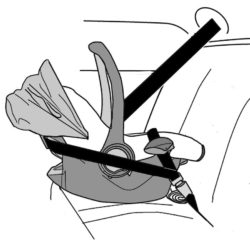European belt routing for rear-facing CRs is not new here in the U.S. For many years there have been at least a few RF-only models with this installation option. However, with growing global influence in the CR marketplace, models with this option have been on the rise in recent years. This article takes a closer look at this installation method.
What is European belt routing?
As the name implies, this technique for installing a CR originated with European models, and many with this option in the U.S. have ties to European manufacturers. In Europe, CRs tend not to have a base, as parents are more apt to use a pram-type stroller rather than a travel system.
With European belt routing (Euro-routing), the lap portion of the belt runs, as usual, through the belt guides of a CR (used without a base), but the shoulder part of the belt routes around the back of the CR shell. Using this method, Euro-routing puts the shoulder portion of the belt to use distributing crash forces and limiting forward rotation (toward the front of the vehicle).
What are the benefits?
In the U.S., FMVSS 213 requires seat belt installations to be tested with a lap-only belt. Since European routing is done only with a lap-shoulder belt, there are no required U.S. tests that measure its benefits. However, drawing from experience in Europe, many manufacturers recognize the benefits of this option and choose to bring that functionality to the U.S. market as an option.
By wrapping the shoulder portion of the belt behind the CR, the back of a RF CR is given extra support. This limits forward rotation and might also prevent contact with interior structures, such as the center console.
It is beneficial for a CR to rotate less because this means the child will be at a more upright angle during a crash. This position distributes impact forces more evenly across the child’s entire back and puts less force on the weaker shoulders. Also, if a CR rotates less, the amount of rebound is controlled because there is less reaction from the CR pressing into the vehicle seat cushions during the initial forces of a crash.
Jeff Durkee of Regal Lager, the distributor of Cybex Aton models with this feature, explains that this has a protective effect on the child’s neck, saying, “When the CR rotates forward, there is a pulling force eventually created along the child’s spine. Called the z-force in crash testing, it’s measured with a special device in the dummy.” The lower the z-force measurement, the better for the occupant, since the spinal cord cannot not stretch without injury. Manufacturers report that z-force is lower when a CR is tested using Euro-routing versus other routing.
What are the limitations?
The primary limitation of European routing is that some lap-shoulder belts don’t have enough webbing to wrap around the back of the CR. Another is that this installation technique can be more challenging for some caregivers. (Many manufacturers that allow this have demonstration videos on their websites that can be very helpful.)
Another deterrent is that most caregivers prefer the convenience of using a base with a RF-only CR, and this method can be used only on CRs that are used baseless.
Euro-routing is never required. Typical routing (with the shoulder portion running directly to the retractor after the lap portion goes through the belt path) is always an option, even in cases in which Euro-routing is also allowed. However, when both methods are offered, it is noteworthy that the manuals for CR models today tend to position Euro-routing as the preferred alternative.
What do caregivers need to know?
Most U.S. caregivers use a base with a RF-only CR, but even those caregivers are likely to have times in which a baseless installation is a good option. Therefore, when CPSTs work with caregivers, it is important to educate about the option to use a RF-only CR without a base (when allowed by the instructions) and explain that this type of installation, when done correctly, is not less safe than installation with the base. This is particularly true when Euro-routing can be used.
When a switchable retractor is used for Euro-routing, it helps to route the belt, tighten the lap portion, and set the angle before switching the retractor to locked mode. Following this sequence of steps tends to make it easier to get a tight installation while maintaining a proper CR angle.
There are a few model-specific details to note. For instance, most models have a guide on the CR seatback for the shoulder belt, which might be a simple slot or a more elaborate clip. Either way, these are typically not belt lock-offs, so be sure to follow instructions for locking the seat belt or using a locking clip, if needed. Note: The Graco Snug Ride Classic Connect 35 manual depicts running the shoulder belt over a prominent notch on the seatback shell before going through the guide, but the company is updating this to clarify that it allows (and prefers) the routing to go under the notch.
Remember to follow the basics
It is also important not to get distracted from the basics when using Euro-routing. The instructions for angle must still be followed, usually by checking a level-to-ground line on the CR label. Also, pay attention to instructions for placement of the handle, which may be different than for use with the base. For example, the Peg Pérego Primo Viaggio 4-35 requires the handle to be placed all the way forward toward the vehicle seatback if the base is not used.

